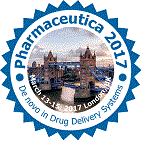
Muyiwa Arisekola
Walter Sisulu University, South Africa
Title: Anti-inflammatory activity of the volatile oil of the pulp of Raphia australis
Biography
Biography: Muyiwa Arisekola
Abstract
Statement of the Problem: Corticosteroids and non-steroidal anti-inflammatory drugs (NSAIDs) have been used for decades in the treatment of inflammatory disorders. Corticosteroids have limitations some of which are depression, glucose intolerance, and susceptibility to infection due to depressed body immunity. NSAIDs also have their side effects due to the undesired depletion of COX-1. After the development of COX-2 specific inhibitors, researchers later discovered that COX-2 also is constitutively produced in the body. The limitations of these NSAIDs have necessitated a research into natural products which show potent anti-inflammatory activity while at the same time do not interfere with the actions of COX-1 and COX-2 which are expressed in some specialized body tissues. The purpose of this study is to look into the use of volatile oil of Raphia australis as an anti-inflammatory agent . Methodology & Theoretical Orientation: The volatile oil of Raphia australis was extracted in hexane using Clevenger Apparatus, after which the GC-MS analysis of the oil was carried out. The anti-inflammatory test was done using four groups (1, 2, 3, and 4) of rats comprising six rats per group. Group one were administered normal saline (0.09% v/v NaCl) while group1,2 and 3 were administered 40mg/kg(oil), 80mg/kg(oil) and 100mg/kg aspirin respectively. Inflammation was induced in all the groups using lipopolysaccharide thirty minutes after treatment by gavage. The major constituents obtained from the GC-MS analysis of the volatile oil are: n-hexadecanoic acid (34.0%), tetradecanoic acid (9.5%), terpinolone (9.1%), dodecanoic acid (9.6%), hotrienol (8.8%), alpha-terpine-1,4-diene (.8%), transbenzalacetone (8.2%), nonanoic acid (7.7%) and beta-ionone (6.0%), lauric acid (9.6%). Conclusion and Significance: The 80mg/kg dose of the oil showed a significant anti-inflammatory effect (P<0.01) when compared to 100mg/kg of aspirin (P<0.01). The analgesic activities of aspirin (P<0.05) and the 80mg/kg dose (P<0.05) of the oil were only significant in the inflammatory phase of the analgesic test.

